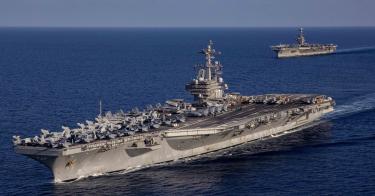Admiral Lisa Franchetti, the new Chief of Naval Operations, faces a gargantuan task. It is now her responsibility to ensure your Navy is manned, equipped, and trained to defend you. Having suffered decades of national apathy and overuse, the Navy now faces a rising Chinese threat. China’s Xi Jinping is working assiduously to build the capacity to win a conflict with the United States this decade. Admiral Franchetti must act with urgency.
Today, the Navy operates 291 warships. This is far below the fleet goal of 355 ships set in 2016, and given the existing threat level, the actual number needed is higher. Since its first assessment in 2015, The Heritage Foundation’s annual Index of Military Strength has consistently graded the Navy as too understrength to ensure success in combat. Despite this dismal reality, world events and political considerations have dictated that the Navy operate at a tempo that has only accelerated wear on it and its people.
Consider the recent reaction to Hamas’ murderous October 7 assault on innocent Israelis and Americans in southern Israel. The day before, the aircraft carrier USS Ford was nearing the end of its scheduled deployment to the region. Now that return home has been delayed, as a second carrier, the USS Eisenhower, joined it in the Eastern Mediterranean. The Eisenhower has since moved into the Arabian Sea, making the odds high that Ford’s deployment will be a long one.
These ships, with their air wings and escorts, offer the president a range of options for responding quickly to rapidly evolving world events. But that capability comes with a cost.
>>> “Lost at Sea”: The Future of the Navy Commission That Congress Created
As Israel takes on Hamas, Iran is directing its other proxies across the Middle East to attack American forces. To meet that threat, the United States has—in addition to the two carrier strike groups—the Bataan amphibious ready group, deployed in the Red Sea. This group of warships carries a contingent of marines, giving the president the ability to send troops ashore to neutralize threats, rescue hostages, or evacuate Americans in the region. The Marines, however, are already on their fourth month of a normal six-month deployment.
Given current events, the Bataan group, like the Ford, is likely to be on call beyond normal deployment timeframes. Furthermore, sustaining this presence in the Middle East with a fleet already at a historically low strength could take away from the deterrent presence needed in other critical theaters.
The top concern has to be a major conflict in Asia, where China has been increasingly aggressive and confidently belligerent. Recent months have witnessed a series of provocative and dangerous encounters involving Chinese naval and air forces. Indeed, since 2021, there have been 180 reckless Chinese military encounters with American assets, more than the sum total of the ten years prior. For example, just last month, a Chinese Coast Guard cutter rammed a Philippine Coast Guard cutter and a government support vessel, which could have triggered U.S. mutual defense obligations. That October ramming makes clear that China is not deterred.
The challenge is how to protect Americans under attack a world away in the Middle East while doing a better job at deterring China.
The top short-term priority should be to get the ships the Navy has today maintained and returned to service quickly. Multiple Government Accountability Office reports and testimony before Congress indicate there is much work needed. Case in point, over the summer, it was reported almost half of the nation’s nuclear submarine fleet was in port waiting for maintenance. That could be deeply dangerous. These vessels can evade China’s deadliest defenses, which makes them critical to winning a war with China.
>>> Navy’s Next Destroyer Is Vital as U.S.–China Tensions Escalate
Over the long term, we should grow the fleet to meet the threats that matter, but until we have the fleet required, the priority must be to operate our naval forces where they can have the greatest strategic impact on China—notably in the South China Sea.
Building this fleet will require shipyard and shipbuilding capacity to include workers and engineers with exquisite skills and experience. Without these resources, the Navy remains hamstrung. Even the current Commander of Fleet Forces Command has called for two additional nuclear maintenance shipyards. Today, there are only four. Sadly, a plan that can grow the fleet, shipyards, and workforce commensurate to the threat has not materialized.
Moreover, Congress has failed to set up a National Commission on the Future of the Navy to develop such a plan. Congress gave itself this task in last year’s National Defense Authorization Act. But while Capitol Hill dithers, threats grow, necessitating ever more drastic actions and expenses to address myriad dangers.
The Navy needs to get the right-sized fleet, the right composition of ships paired, and a solid budget to make it a reality. All of this is long past due. The Secretary of Defense intervened and delayed naval force planning in the winter of 2020, and the Navy has never really recovered the momentum needed to complete this task.
This is where Admiral Franchetti needs to weigh in aggressively, with world events as the backdrop for urgency. If she fails to do so, Congress will have to be much more forward-leaning.
This piece originally appeared in The National Interest https://nationalinterest.org/feature/us-navy-fit-purpose-207484





